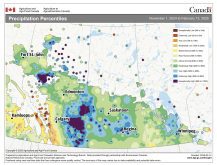This cattle market information is selected from the weekly report from Canfax, a division of the Canadian Cattlemen’s Association. More market information, analysis and statistics are available by becoming a Canfax subscriber by calling 403-275-5110 or at www.canfax.ca.
Fed market soft
The cash market was lacklustre last week with soft buying interest and unenthusiastic feedlot sellers. Moderate trade saw dressed sales generally $3 to $6 per hundredweight lower than the previous week from $257-$257.50 per cwt. delivered.
Read Also

USDA’s August corn yield estimates are bearish
The yield estimates for wheat and soybeans were neutral to bullish, but these were largely a sideshow when compared with corn.
Weighted average steer and heifer prices closed last week $2.11 per cwt. and $3.38 per cwt. lower than the previous week, respectively. A few feedlots offered cash cattle but total sale volumes were larger than the previous week.
Total Canadian fed slaughter for the week ending Oct. 23 surged 14 percent higher than the previous week to 58,461 head and was almost 16 percent larger than the five-year average. Year to date Canadian fed slaughter was nine percent larger than year ago, totalling 2,282,525 head.
Canadian steer carcass weights were one pound larger than the previous week at 951 lb. and were two lb. higher than the same week last year. Ontario steer weights were significantly 15 lb. lower than the previous week while Alberta steer weights were five lb. heavier.
Thanksgiving and its four-day week ending Oct. 16 saw Canadian fed cattle/cow exports to the United States down 14 percent from the previous week to 8,957 head. Year to date slaughter cattle exports were down 12 percent, totalling 339,872 head.
Ontario saw active trade with most sales sideways at $270 per cwt. delivered.
Market ready feedlot supplies are beginning to tighten but captive packer inventories remain ample.
In the U.S., fed prices strengthened on tightened supplies and southern live prices ranged from US$124-$127 per cwt. Northern live trade was reported $1-$2 per cwt. higher than the previous week with sales form $126-$128 per cwt.
Cows set new lows
Last week was disappointing for the non-fed market. Butcher cow and bull prices set fresh lows for the year. D2 cows averaged $63.20 and D3s averaged $54.33 per cwt. Butcher bulls averaged $92.88.
Non-fed volumes picked up through commercial auction facilities but supplies seem smaller than normal for this time of year. The market has not been able to handle the increase in volume as in other years and U.S. packers have become more active.
Western Canadian cow slaughter for the week ending Oct. 23 totalled just over 6,000 head, nine percent larger than last year. Since the start of July, cow slaughter volumes are 25 percent larger than last year but in line with 2019.
Bred cow sales are just around the corner. Traditionally the slaughter market puts a floor price on the bred cow market. The way things are shaping up, the floor price on a bred cow is $800-$900 per head. Demand for bred cows is expected to be good enough to keep them from the slaughter mix.
Cutouts gain ground
In U.S. beef trade, cutout values gained seasonal momentum last week on improved buying interest in middle and end cuts. The Choice cutout was US$4.23 higher last week, averaging $284.89, and Select traded steady at $262.64 per cwt.
U.S. cattle slaughter last week was estimated at 668,000 head.
Heavy auction action
Alberta auction volumes totalled more than 95,000 head of calves, feeders, non-fed and bred cattle and have likely peaked for the year. In the previous two weeks, British Columbia, Alberta, Saskatchewan and Manitoba volumes were 91,000 head larger than last year and 51,000 head larger than the five-year average.
Heifer volumes seem a bit bigger than usual. At many sales, they make up 40 to 50 percent of the total offering. For some grass operators, a risk management strategy is to buy half their inventory in fall and the other half in spring. As a result, grass buyers have become more active on the lightweight calf market with particular interest on 400-500 lb. calves.
After dropping around $10 per cwt. through October, 500-600 lb. calf prices are showing signs of stability. On a cash-to-cash basis, Alberta calf prices are at a $5 per cwt. premium to the U.S. market. U.S. calf and feeder prices were stronger last week and the premium between Western Canada and the U.S. might continue to shrink.
Bigger calves over 700 lb. have hit a rough patch, which is seasonally not uncommon. Steers 700-800 lb. usually peak in October and trend lower into this month and December.
















